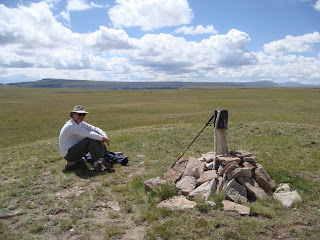Mark Twain has always been one of our favorite authors. The Creede Repertory Theatre, which we have
mentioned earlier in this blog, is producing Is He Dead?, a play that he
wrote in Europe in the late 1890s. It
was never performed until just recently.
It’s ironic that perhaps his funniest play took 100 years to be
produced. We attended CRT’s earlier
production of Mrs. Manners, which we thoroughly enjoyed. Although we expected a good show Tuesday
night, we were blown away! We were
members of the Denver Center Theatre Company for many years when we lived in
Denver, yet we have never seen a better performance than the one we saw Tuesday
night. It was so funny our faces hurt
from laughing. We aren’t amused by
trifles. When we exited the theatre, the
entire cast was lined up out on the sidewalk to greet the audience. What a top notch finish to a really fun
evening of entertainment. CRT is taking Is
He Dead? on the road to the Arvada Center in October. If you live on the Front Range of Colorado,
you should make this play a priority—we promise that you will be thoroughly
entertained and will have one of the best laughs you have had in a long time.
Most of the hiking trails in this region are nearly
vertical. Wednesday’s outing was no
exception. We like the Colorado Trail
and the Continental Divide Trail, and here they are combined for long
stretches. We decided to resume our
exploration of the east side of Spring Creek Pass with a trek up to Snow Mesa
(we blogged earlier about our experiences on San Luis Pass several miles east
of this hike). Spring Creek Pass is
about 10,900’ and Snow Mesa is about 12,300’+/-; that’s approximately 1,400’
over two or so miles. Going up was a
grind as the trail never leveled off for a breather or a stop for morning tea
for the first mile and a half. The most
interesting thing about the hike up other than the views was the prevalence of
exceeding large cairns. They are usually
just small piles of rocks used to mark a faint trail, but these babies were
huge. Above timberline, the trail
entered and followed a large talus slope all the way to the top of Snow
Mesa. Actually it was more of a talus
mountain than a slope.

A Very Large Cairn

A Mega Cairn
Talus Slope Trail
However, once we were clear of the tree line, the views to
the west and northwest were spectacular.
On top of Snow Mesa, where tundra prevails, we had 360°
views of the San Juan Mountains and the
Weminuche, La Garita, and the Uncompahgre Wilderness areas, including
the previously blogged about Alpine Loop.
We could easily see a cluster of five fourteeners: Uncompahgre Peak,
Wetterhorn Mtn., Handies Peak, Redcloud Peak, and Sunshine Peak to the west and
one, San Luis Peak, to the east. In
every direction there were more thirteeners than you could count or name. Had the wind not been so vigorous and cold on
Snow Mesa, we could have stayed up there for hours just soaking in the
views. Instead, we retreated downhill
for lunch among the rocks only to be scolded by pikas, marmots, and other
rodent denizens of the talus region.
Uncompahgre Peak & Wetterhorn Mtn
On Top of Snow Mesa
Downward Bound
Our trip down was largely uneventful except for being caught
and passed by four young backpackers.
The first two caught up with us just after we finished lunch when we
were almost back to the tree line. They
were descending rapidly and clearly had more confidence in their ankle strength
on the rocky trail than we did. Several
minutes later a third young man passed us; he was going slower than his
companions and took the time to wish us a great day. Nearly ten minutes later the final person in
that group arrived. He was much slower
than the others, yet laughed about it when we teased him about being a
slowpoke. It turned out that they were
hiking all the way from west of Denver to Durango on the Colorado Trail and had
been out 21 days. He said the other
fellows were just 16 & 17, and as the old man at 21, he had a hard time
keeping up with them, especially going downhill—that was a true statement as we
had seen them together as they started down from Snow Mesa. Imagine being the “old man” at 21. Biologically, we could easily have been their
grandparents: Makes one feel pretty good
to be joining them out on the trail—even if it were for just a day at a time
rather than weeks at a time.
Our View from our Lunch Stop



















































